Common LDAP operation (for YunoHost but not only)¶
Moulinette is deeply integrated with LDAP which is used for a series of things like:
- storing users
- storing domains (for users emails)
- SSO
This page document how to uses it on a programming side in YunoHost.
Getting access to LDAP in a command¶
To get access to LDAP you need to authenticate against it, for that you need to declare your command with requiring authentication in the Principle this way:
configuration:
authenticate: all
Here is a complete example:
somecommand:
category_help: ..
actions:
### somecommand_stuff()
stuff:
action_help: ...
api: GET /...
configuration:
authenticate: all
This will prompt the user for a password in CLI.
If you only need to read LDAP (and not modify it, for example by listing
domains), then you prevent the need for a password by using the
ldap-anonymous authenticator this way:
configuration:
authenticate: all
authenticator: ldap-anonymous
Once you have declared your command like that, your python function will
received the auth object as first argument, it will be used to talk to
LDAP, so you need to declare your function this way:
def somecommand_stuff(auth, ...):
...
auth in the moulinette code¶
The auth object is an instance of moulinette.authenticators.ldap.Authenticator class.
Here its docstring:
-
class
moulinette.authenticators.ldap.Authenticator(name, vendor, parameters, extra)[source]¶ LDAP Authenticator
Initialize a LDAP connexion for the given arguments. It attempts to authenticate a user if ‘user_rdn’ is given - by associating user_rdn and base_dn - and provides extra methods to manage opened connexion.
- Keyword arguments:
- uri – The LDAP server URI
- base_dn – The base dn
- user_rdn – The user rdn to authenticate
LDAP Schema¶
This is a generated example of the ldap schema provided by YunoHost
(to generate this graph uses make ldap_graph, you’ll need graphviz):
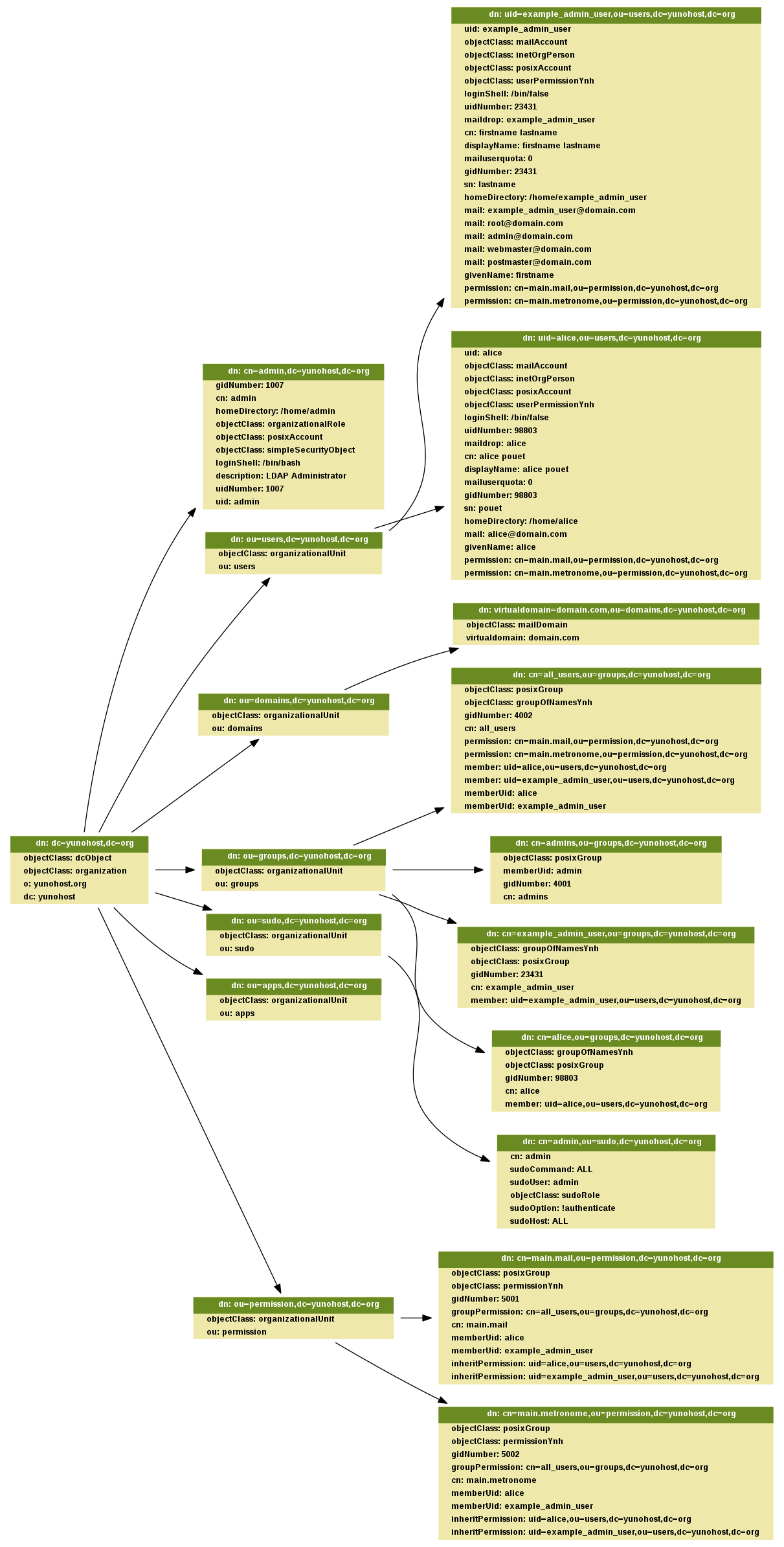
Reading from LDAP¶
Reading data from LDAP is done using the auth object received as first
argument of the python function. To see how to get this object read the
previous section.
The API looks like this:
auth.search(ldap_path, ldap_query)
This will return a list of dictionary with strings as keys and list as values.
You can also specify a list of attributes you want to access from LDAP using a list of string (on only one string apparently):
auth.search(ldap_path, ldap_query, ['first_attribute', 'another_attribute'])
For example, if we request the user alice with its homeDirectory, this would look like this:
auth.search('ou=users,dc=yunohost,dc=org', '(&(objectclass=person)(uid=alice))', ['homeDirectory', 'another_attribute'])
And as a result we will get:
[{'homeDirectory': ['/home/alice']}]
Notice that even for a single result we get a list of result and that every value in the dictionary is also a list of values. This is not really convenient and it would be better to have a real ORM, but for now we are stuck with that.
Apparently if we don’t specify the list of attributes it seems that we get all attributes (need to be confirmed).
Here is the method docstring:
-
Authenticator.search(base=None, filter='(objectClass=*)', attrs=['dn'])[source]¶ Search in LDAP base
Perform an LDAP search operation with given arguments and return results as a list.
- Keyword arguments:
- base – The dn to search into
- filter – A string representation of the filter to apply
- attrs – A list of attributes to fetch
- Returns:
- A list of all results
Users LDAP schema¶
According to ldapvi this is the user schema (on YunoHost >3.7):
# path: uid=the_unix_username,ou=users,dc=yunohost,dc=org
uid: the_unix_username
objectClass: mailAccount
objectClass: inetOrgPerson
objectClass: posixAccount
objectClass: userPermissionYnh
loginShell: /bin/false
uidNumber: 80833
maildrop: the_unix_username # why?
cn: first_name last_name
displayName: first_name last_name
mailuserquota: some_value
gidNumber: 80833
sn: last_name
homeDirectory: /home/the_unix_username
mail: the_unix_username@domain.com
# if the user is the admin he will also have the following mails
mail: root@domain.com
mail: admin@domain.com
mail: webmaster@domain.com
mail: postmaster@domain.com
givenName: first_name
memberOf: cn=the_unix_username,ou=groups,dc=yunohost,dc=org
memberOf: cn=all_users,ou=groups,dc=yunohost,dc=org
permission: cn=main.mail,ou=permission,dc=yunohost,dc=org
permission: cn=main.metronome,ou=permission,dc=yunohost,dc=org
The admin user is a special case that looks like this:
# path: cn=admin,dc=yunohost,dc=org
gidNumber: 1007
cn: admin
homeDirectory: /home/admin
objectClass: organizationalRole
objectClass: posixAccount
objectClass: simpleSecurityObject
loginShell: /bin/bash
description: LDAP Administrator
uidNumber: 1007
uid: admin
Other user related schemas:
# path: cn=admins,ou=groups,dc=yunohost,dc=org
objectClass: posixGroup
objectClass: top
memberUid: admin
gidNumber: 4001
cn: admins
# path: cn=admin,ou=sudo,dc=yunohost,dc=org
# this entry seems to specify which unix user is a sudoer
cn: admin
sudoCommand: ALL
sudoUser: admin
objectClass: sudoRole
objectClass: top
sudoOption: !authenticate
sudoHost: ALL
Reading users from LDAP¶
The user schema is located at this path: ou=users,dc=yunohost,dc=org
According to already existing code, the queries we uses are:
'(&(objectclass=person)(!(uid=root))(!(uid=nobody)))'to get all users (not that I’ve never encountered users withrootornobodyuid in the ldap database, those might be there for historical reason)'(&(objectclass=person)(uid=%s))' % usernameto access one user data
This give us the 2 following python calls:
# all users
auth.search('ou=users,dc=yunohost,dc=org', '(&(objectclass=person)(!(uid=root))(!(uid=nobody)))')
# one user
auth.search('ou=users,dc=yunohost,dc=org', '(&(objectclass=person)(uid=some_username))')
Apparently we could also access one user using the following path (and not query): uid=user_username,ou=users,dc=yunohost,dc=org but I haven’t test it.
If you want specific attributes look at the general documentation on how to read from LDAP a bit above of this section.
Group LDAP schema¶
According to ldapvi this is the user schema (on YunoHost >3.4):
The groups will look like this:
dn: cn=the_unix_username,ou=groups,dc=yunohost,dc=org
objectClass: top
objectClass: groupOfNamesYnh
objectClass: posixGroup
gidNumber: 48335
cn: the_unix_username
structuralObjectClass: posixGroup
member: uid=the_unix_username,ou=users,dc=yunohost,dc=org
By default you will find in all case a group named all_users which will contains all Yunohost users.
# path dn: cn=all_users,ou=groups,dc=yunohost,dc=org
objectClass: posixGroup
objectClass: groupOfNamesYnh
gidNumber: 4002
cn: all_users
structuralObjectClass: posixGroup
permission: cn=main.mail,ou=permission,dc=yunohost,dc=org
permission: cn=main.metronome,ou=permission,dc=yunohost,dc=org
member: uid=the_unix_username,ou=users,dc=yunohost,dc=org
memberUid: the_unix_username
Reading group from LDAP¶
The group schema is located at this path: ou=groups,dc=yunohost,dc=org
The queries we uses are the 2 following python calls:
# all groups
auth.search('ou=groups,dc=yunohost,dc=org', '(objectclass=groupOfNamesYnh)')
# one groups
auth.search(base='ou=groups,dc=yunohost,dc=org', filter='cn=' + groupname)
Permission LDAP schema¶
According to ldapvi this is the user schema (on YunoHost >3.4):
The permission will look like this:
dn: cn=main.mail,ou=permission,dc=yunohost,dc=org
objectClass: posixGroup
objectClass: permissionYnh
gidNumber: 5001
groupPermission: cn=all_users,ou=groups,dc=yunohost,dc=org
cn: main.mail
structuralObjectClass: posixGroup
memberUid: the_unix_username
inheritPermission: uid=the_unix_username,ou=users,dc=yunohost,dc=org
By default you will have a permission for the mail and for metronome. When you install an application a permission also created.
Reading permissions from LDAP¶
The permission schema is located at this path: ou=permission,dc=yunohost,dc=org
The queries we uses are the 2 following python calls:
# For all permission
auth.search('ou=permission,dc=yunohost,dc=org', '(objectclass=permissionYnh)')
# For one permission
auth.search(base='ou=permission,dc=yunohost,dc=org', filter='cn=' + permission_name)
Domain LDAP schema¶
According to ldapvi this is the domain schema (on YunoHost 2.7):
10 virtualdomain=domain.com,ou=domains,dc=yunohost,dc=org
objectClass: mailDomain
objectClass: top
virtualdomain: domain.com
Adding data in LDAP¶
If you add an object linked to user, group or permission you need run the function permission_sync_to_user to keep integrity of permission in LDAP.
Adding stuff in LDAP seems pretty simple, according to existing code it looks like this:
auth.add('key=%s,ou=some_location', {'attribute1': 'value', ...})
They weird stuff is the path you need to create. This looks like that for domain and users:
# domain
auth.add('virtualdomain=%s,ou=domains' % domain, attr_dict)
# user
auth.add('uid=%s,ou=users' % username, attr_dict)
You need to respect the expected attributes. Refer to the schema for that.
auth.add seems to return something false when it failed (None probably)
so you need to check it’s return code.
Here is the docstring:
-
Authenticator.add(rdn, attr_dict)[source]¶ Add LDAP entry
- Keyword arguments:
- rdn – DN without domain attr_dict – Dictionnary of attributes/values to add
- Returns:
- Boolean | MoulinetteError
Adding user in LDAP¶
Here is how it’s done for a new user:
auth.add('uid=%s,ou=users' % username, {
'objectClass': ['mailAccount', 'inetOrgPerson', 'posixAccount'],
'givenName': firstname,
'sn': lastname,
'displayName': '%s %s' % (firstname, lastname),
'cn': fullname,
'uid': username,
'mail': mail,
'maildrop': username,
'mailuserquota': mailbox_quota,
'userPassword': user_pwd,
'gidNumber': uid,
'uidNumber': uid,
'homeDirectory': '/home/' + username,
'loginShell': '/bin/false'
})
Adding a domain in LDAP¶
Here is how it’s done for a new domain:
auth.add('virtualdomain=%s,ou=domains' % domain, {
'objectClass': ['mailDomain', 'top']
'virtualdomain': domain,
})
Updating LDAP data¶
If you add an object linked to user, group or permission you need run the function permission_sync_to_user to keep integrity of permission in LDAP.
Update a user from LDAP looks like a simplified version of searching. The syntax is the following one:
auth.update(exact_path_to_object, {'attribute_to_modify': 'new_value', 'another_attribute_to_modify': 'another_value', ...})
For example this will update a user loginShell:
auth.update('uid=some_username,ou=users', {'loginShell': '/bin/bash'})
I don’t know how this call behave if it fails and what it returns.
Here is the method docstring:
-
Authenticator.update(rdn, attr_dict, new_rdn=False)[source]¶ Modify LDAP entry
- Keyword arguments:
- rdn – DN without domain attr_dict – Dictionnary of attributes/values to add new_rdn – New RDN for modification
- Returns:
- Boolean | MoulinetteError
Updating a user in LDAP¶
This is done this way:
auth.update('uid=some_username,ou=users', {'attribute': 'new_value', ...})
Refer to the user schema to know which attributes you can modify.
Validate uniqueness¶
There is a method to validate the uniqueness of some entry that is used during user creation. It’s useful by example to be sure that we have no conflict about email between each user.
Here is how it’s used (I don’t understand why a path is not provided):
# Validate uniqueness of username and mail in LDAP
auth.validate_uniqueness({
'uid': username,
'mail': mail
})
And here is its docstring:
-
Authenticator.update(rdn, attr_dict, new_rdn=False)[source] Modify LDAP entry
- Keyword arguments:
- rdn – DN without domain attr_dict – Dictionnary of attributes/values to add new_rdn – New RDN for modification
- Returns:
- Boolean | MoulinetteError
Get conflict¶
Like the last function validate_uniqueness but give instead of rising an error this function return which attribute with witch value generate a conflict.
# Validate uniqueness of groupname in LDAP
conflict = auth.get_conflict({
'cn': groupname
}, base_dn='ou=groups,dc=yunohost,dc=org')
if conflict:
raise YunohostError('group_name_already_exist', name=groupname)
Remove entries from LDAP¶
If you add an object linked to user, group or permission you need run the function permission_sync_to_user to keep integrity of permission in LDAP.
Remove entries from LDAP is very simple, quite close to adding stuff except you don’t need to specify the attributes dict, you just need to entrie path:
auth.remove(path)
Here how it looks like for domain and user:
# domain
auth.remove('virtualdomain=%s,ou=domains' % domain)
# user
auth.remove('uid=%s,ou=users' % username)
auth.remove returns something that evaluate to False when it fails
(None ?) so you need to check it returns code.
Reading LDIF file¶
Reading parsing a ldif to be able to insert in the LDAP database is really easy. Here is how to get the content of a LDIF file
from moulinette.utils.filesystem import read_ldif
my_reslut = read_ldif("your_file.ldif")
Note that the main difference of what the auth object return with the search method is that this function return a 2-tuples with the “dn” and the LDAP entry.
LDAP architecture in Yunohost¶
In Yunohost to be able to manage the user and the permission we use 3 parts:
- User object
- Permission object
- Group object
We can see the interaction between these object as this following:
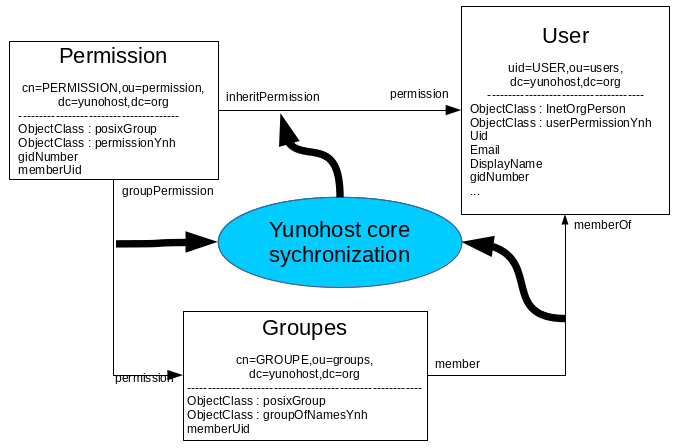
As you can see there are link between these 3 objets:
- The first link is between the user and the group. It define which user is in which group. Note that all user has a group with his name. Note that in all Yunohost instance you have a group named all_users. In this group you will find all Yunohost users.
- The second link is between the permission and the groups. This link is defined by the administrator. By default all permission are linked to the group all_users, so all user will be allowed to access to this permission.
- The third link between the User and the Permission is more technical. It give the possibility to the application to get a list of all user allowed to access to. This link is dynamically generated by core. The function permission_sync_to_user in the module permission do this work.
The option force of the function permission_sync_to_user is used when you add the data to LDAP with slapadd. slapadd update the LDAP database without the LDAP demon process. The advantage of this is that you can bypass the integrity check (like the link between the object by the memberOf overlay). The disadvantage is that the the memberOf overlay wont update anything so if you don’t fix the integrity after after to run slapadd, the permission in LDAP might be corrupted. Running the function permission_sync_to_user` with the option force will do this work to fix all integrity error.
To be able to have an attribute in both is of theses 3 link we use the memberOf overlay in LDAP. This following line define the configuration to have these 3 link dynamically updated :
# Link user <-> group
#dn: olcOverlay={0}memberof,olcDatabase={1}mdb,cn=config
overlay memberof
memberof-group-oc groupOfNamesYnh
memberof-member-ad member
memberof-memberof-ad memberOf
memberof-dangling error
memberof-refint TRUE
# Link permission <-> groupes
#dn: olcOverlay={1}memberof,olcDatabase={1}mdb,cn=config
overlay memberof
memberof-group-oc permissionYnh
memberof-member-ad groupPermission
memberof-memberof-ad permission
memberof-dangling error
memberof-refint TRUE
# Link permission <-> user
#dn: olcOverlay={2}memberof,olcDatabase={1}mdb,cn=config
overlay memberof
memberof-group-oc permissionYnh
memberof-member-ad inheritPermission
memberof-memberof-ad permission
memberof-dangling error
memberof-refint TRUE
This foolwing example show how will be represented in LDAP as simple concept of permission.
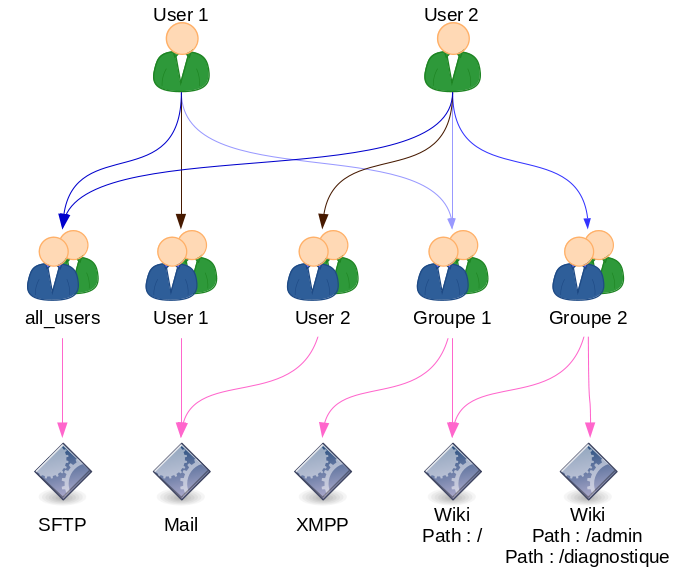
This schema show what will be in LDAP in these following schema:
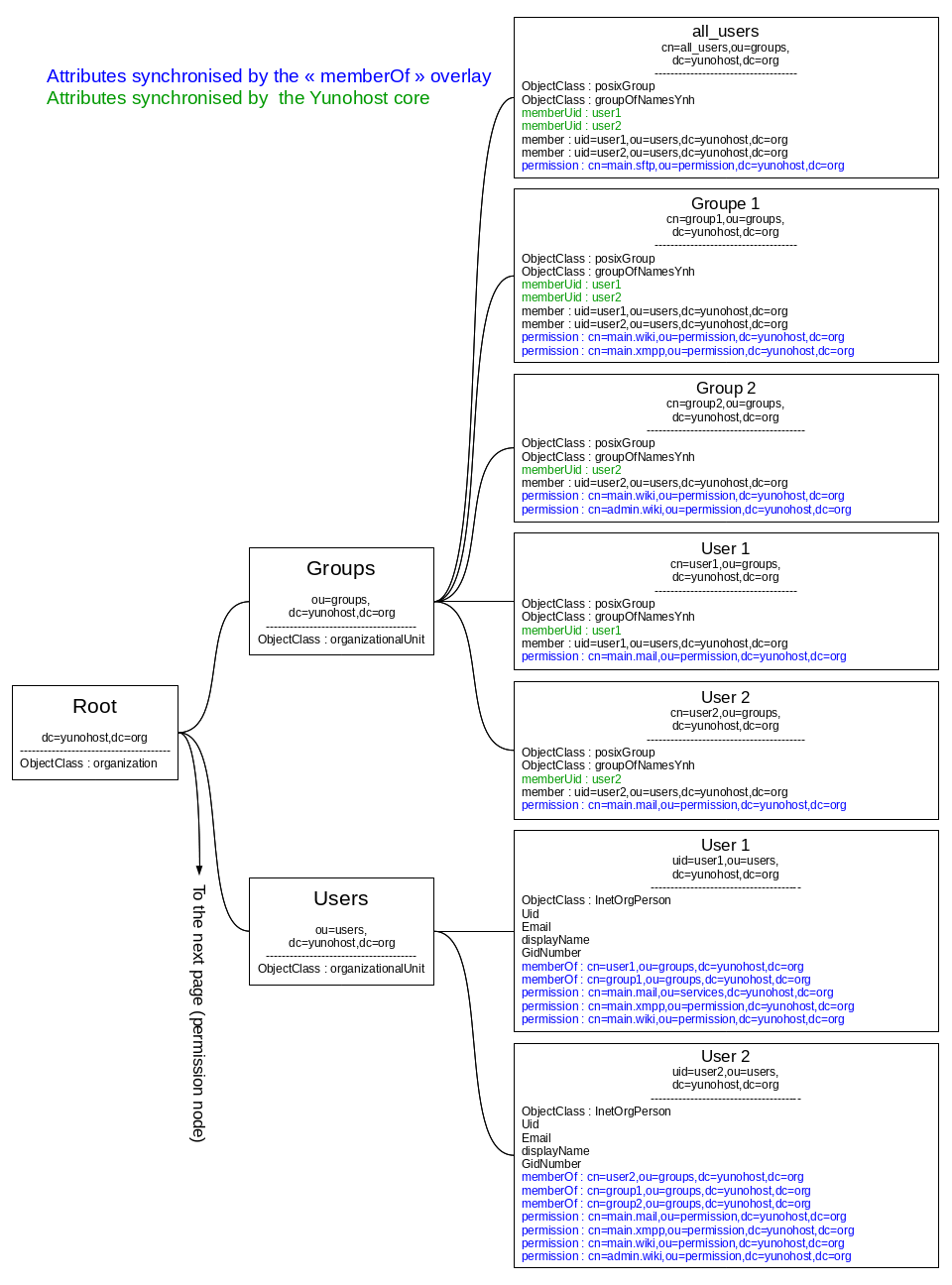
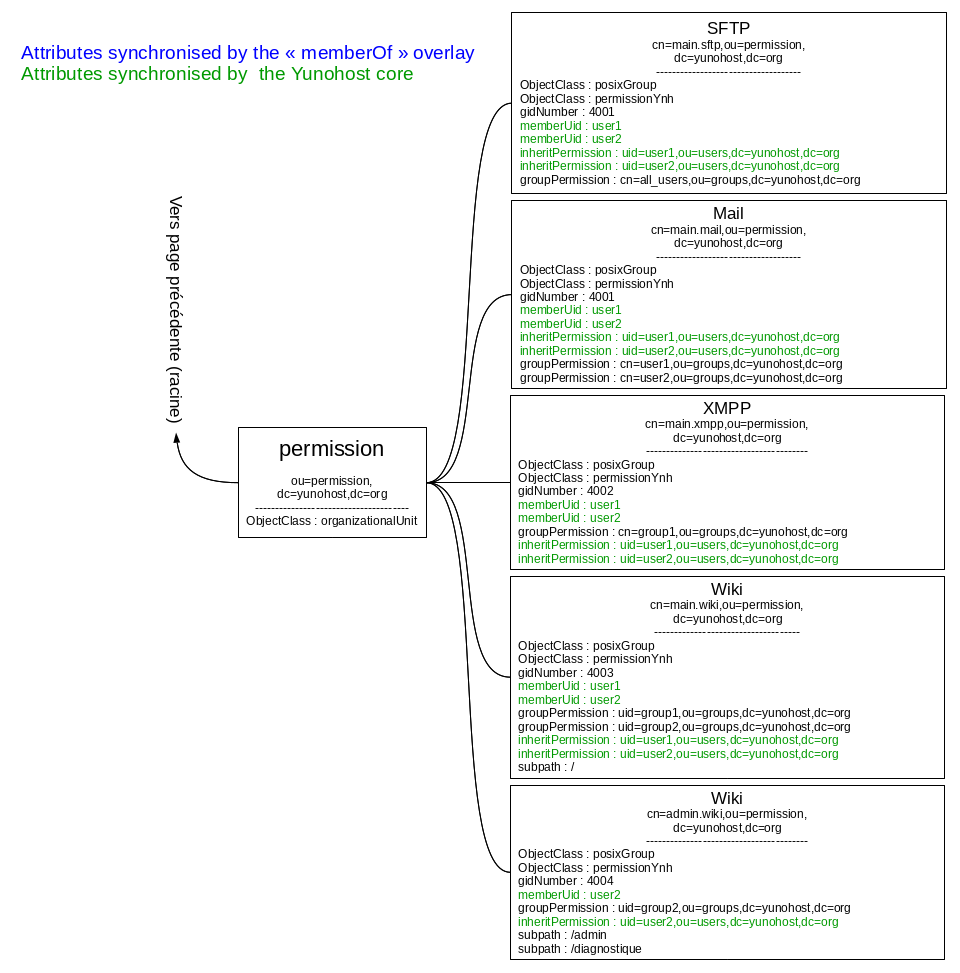
LDAP integration in Yunohost applications¶
To have a complete integration of LDAP in your application you need to configure LDAP as follow :
Host: ldap://localhost
Port: 389
Base DN: dc=yunohost,dc=org
User DN: ou=users,dc=yunohost,dc=org
Group DN: ou=groups,dc=yunohost,dc=org
fiter : (&(objectClass=posixAccount)(permission=cn=YOUR_APP.main,ou=permission,dc=yunohost,dc=org))
LDAP Username: uid
LDAP Email Address: mail
By this your application will get the list of all user allowed to access to your application.